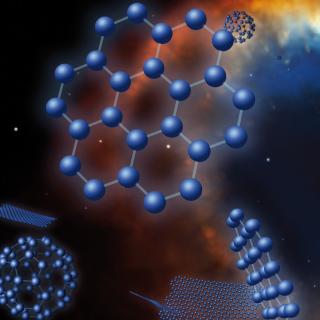Górny, S. K.; Perea-Calderón, J. V.; García-Hernández, D. A.; García-Lario, P.; Szczerba, R.
Bibliographical reference
Astronomy and Astrophysics, Volume 516, id.A39
Advertised on:
6
2010
Journal
Citations
17
Refereed citations
15
Description
Aims: We investigate Galactic bulge planetary nebulae without
emission-line central stars for which peculiar infrared spectra have
been obtained with the Spitzer Space Telescope, including the
simultaneous signs of oxygen and carbon based dust. Three separate
sub-groups can be defined characterized by the different chemical
composition of the dust and the presence of crystalline and amorphous
silicates. Methods: We use literature data to analyze the
different nebular properties and deduce both the evolutionary status and
the origin of these three groups. In particular, we check whether there
are signs of evolutionary links between dual-dust chemistry planetary
nebulae without detected emission-line central stars and those with
emission-line stars. Results: Our primary finding is that the
classification based on the dust properties is reflected in the more
general properties of these planetary nebulae. However, some observed
properties are difficult to relate to the common view of planetary
nebulae. In particular, it is challenging to interpret the peculiar gas
chemical composition of many analyzed objects in the standard picture of
the evolution of planetary nebulae progenitors. We confirm that the
dual-dust chemistry phenomenon is not limited to planetary nebulae with
emission-line central stars. Conclusions: Our results clearly
indicate that there is no unique road to the formation of planetary
nebulae even in a homogeneous environment such as the Galactic bulge.
The evolution of a single asymptotic giant branch star may lead to the
formation of different types of planetary nebulae. In addition, the
evolution in a close binary system should sometimes also be considered.
Based on observations made with the Spitzer Space Telescope, which is
operated by the Jet Propulsion Laboratory, California Institute of
Technology, under NASA contract 1407.
Related projects

Nucleosynthesis and molecular processes in the late stages of Stellar Evolution
Low- to intermediate-mass (M < 8 solar masses, Ms) stars represent the majority of stars in the Cosmos. They finish their lives on the Asymptotic Giant Branch (AGB) - just before they form planetary nebulae (PNe) - where they experience complex nucleosynthetic and molecular processes. AGB stars are important contributors to the enrichment of the
Domingo Aníbal
García Hernández